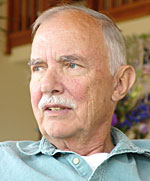Lewis M. Branscomb
Obituary
8/17/1926 to 5/31/2023
NIST, The National Institutes of Standards and Technology has published a commemorative statement about Lewis Branscomb, a former director of the same entity previously known as the National Bureau of Standards.
This New York Times obituary for Dr. Branscomb posted on July 4, 2023.
JILA at the University of Colorado in conjunction with the National Institutes of Standards and Technology (NIST) published this commemorative webpage.
The Harvard Kennedy School Belfer Center published this commemorative webpage.
Obituary edited by Harvie H. Branscomb 7/4/2023 updated 7/26/2023
Lewis McAdory Branscomb has died at the age of 96 of natural causes almost four years after suffering from severe brain trauma. Prior to a tragic fall in 2019 he focused his career on research and innovation policy, and on information infrastructure, economic equity and security policies to make the world safer. His participation in launching the Center for Science & Democracy within the Union for Concerned Scientists reflected his top concern- the management of science and technology in the furtherance of democratic governance. Anyone intending to commemorate Lewis Branscomb with a financial gift might consider this project.
Lewis Branscomb was born 8/17/1926 in Asheville North Carolina and spent much of his childhood in Durham. His early schooling was at the Asheville School and at the Webb School in Bell Buckle Tennessee. Lewis's brothers Ben Branscomb,MD from Birmingham, Alabama and Harvie Branscomb Jr. a lawyer from Corpus Christi, Texas are deceased. Lewis was married in 1951 to Anne Wells Branscomb until her death 46 years later. In 2005 he married Constance Mullin Branscomb who resides in a memory care facility in La Jolla California.
Lewis Branscomb is also survived by a son, Harvie H. Branscomb of El Jebel, CO, his partner Yayoi Wakabayashi, Lewis's daughter KC Branscomb of Half Moon Bay, California, and her daughter Clara Louise Kelley of Mountain View California. Members of the family can be reached by email at lmb@zgsw.com.
Lewis was throughout life an avid world traveler, sailor, hiker, skier and scuba diver.
Lewis graduated with a BA in physics from Duke University summa cum laude in 1945. He served as a junior officer in the US Naval Reserve in the Philippines during World War II in command of a naval vessel. He received his PhD in physics from Harvard in 1949, when he was appointed Junior Fellow in the Harvard Society of Fellows. Branscomb sang the role of the professor accompanied by Tom Lehrer in front of a 1951 Harvard physics class he was teaching as a graduate student. The Physical Revue (lyrics by Tom Lehrer), was a unique musical presentation performed with other graduate students as a comedic preparation for a final exam. Dr. Branscomb took a job as a research physicist at the U.S. National Bureau of Standards (NBS, now the National Institute for Standards and Technology) from 1951 to 1972, during the latest three years serving as Director.
He, with Stephen J. Smith, performed groundbreaking research in astrophysics: the crossed-beam study of structure and spectra of atomic and molecular negative ions. In 1962 he co-founded and became the first Chairman of the Joint Institute for Laboratory Astrophysics (JILA) in Boulder, CO after moving a division of the Bureau of Standards from DC to the University of Colorado campus in Boulder. Branscomb's own recollections are recorded here. More on JILA here: Celebrating 60 Years of JILA
He was appointed Director of the National Bureau of Standards by President Nixon in 1969. In 1972 he was named Vice President and Chief Scientist of IBM Corporation and later a member of the IBM Corporate Management Board. An article in Science describes Branscomb's transition from government to corporation.
In 1980 President Carter appointed him to the National Science Board becoming chairman between 1982 and 1984. The Advisory Committee on Antarctic Names recognized his substantial contribution to the ecological protection of the continent with the naming of Branscomb Peak and Branscomb Glacier. The latter serves as a base camp for ascents of the highest point in Antarctica.
Branscomb was appointed by President Johnson to the President's Science Advisory Committee (1964-1968) and served as Chair of the Space Science Panel during the early Apollo years. Later he served President Reagan on the National Productivity Advisory Committee. He is a member of all three National Academies: of Sciences, of Engineering and of Medicine. Lewis served as President of the American Physical Society in 1979. Branscomb served as Editor of the Reviews of Modern Physics from 1963-1969.
He holds honorary doctorates from fifteen universities. He has served on the boards of several corporations including Mobil, General Foods, MITRE, Draper Laboratories and Lord Corporation. For a continuous period of 57 years he and/or his father B. Harvie Branscomb served as trustees of Vanderbilt University. They were both Rhodes Scholars. Lewis served as a trustee of Woods Hole Oceanographic Institution, and on the board of the National Geographic Society. From 1984 to 1986 was an Overseer of Harvard University. In December, 1998, he was awarded the Okawa Prize "for outstanding contributions to the progress of informatics, scientific and technological policy and corporate management."
In 2001 he received the Vannevar Bush Award from the National Science Board "for his distinguished public service in the development of U.S. science and technology policy; a scientist, teacher, scholar, business leader and author who has influenced policies of recent Administrations, he has been an inspiration to students and colleagues and a valuable asset to the Nation." In 2013 the American Association for the Advancement of Science awarded him the Philip Hauge Abelson Prize.
See more details in Lewis's CV .Prof. Branscomb has written extensively on information technology, comparative science and technology policy, and management of technology. His books are available for loan in digital format from the Internet Archive (archive.org):
The American Institute of Physics shared information about Lewis Branscomb's life including a timeline.

